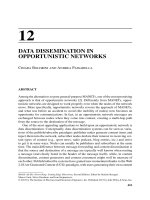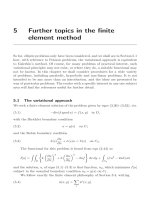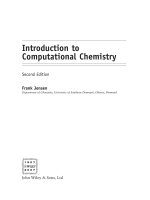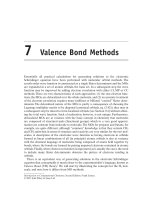Ebook Pharmacology for health professionals (2nd edition) Part 1
Bạn đang xem bản rút gọn của tài liệu. Xem và tải ngay bản đầy đủ của tài liệu tại đây (5.34 MB, 262 trang )
PHARMACOLOGY FOR
HEALTH PROFESSIONALS
Second Edition
W. RENÉE ACOSTA, RPH, MS
College of Pharmacy
University of Texas at Austin
Acosta Main Book_FM.indd i
2/11/2012 6:42:58 PM
Executive Editor: David B. Troy
Product Manager: Matt Hauber
Art Director: Jennifer Clements
Vendor Manager: Cynthia Rudy
Design Coordinator: Stephen Druding
Manufacturing Coordinator: Margie Orzech
Developmental Editor: Rose Foltz
Production Services/Compositor: SPi Global
Copyright © 2013 Wolters Kluwer Health | Lippincott Williams & Wilkins
351 West Camden Street
Two Commerce Square
Baltimore, MD 21201
2001 Market Street
Philadelphia, PA 19103
All rights reserved. This book is protected by copyright. No part of this book may be reproduced in any form by any means, including photocopying, or utilized by any information
storage and retrieval system without written permission from the copyright owner, except
for brief quotations embodied in critical articles and reviews. Materials appearing in this
book prepared by individuals as part of their official duties as U.S. government employees
are not covered by the above-mentioned copyright.
Printed in China
Library of Congress Cataloging-in-Publication Data
Acosta, W. Renée.
Pharmacology for health professionals. — 2nd ed. / W. Renée Acosta.
p. ; cm.
Rev. ed. of: Pharmacology for health professionals / Sally Roach. 1st ed. c2005.
Includes bibliographical references and index.
ISBN 978-1-60831-575-8
I. Roach, Sally S. Pharmacology for health professionals. II. Title.
[DNLM: 1. Pharmaceutical Preparations. 2. Pharmacology. QV 55]
615’.1—dc23
2011048150
Care has been taken to confirm the accuracy of the information presented and to describe
generally accepted practices. However, the authors, editors, and publisher are not responsible for errors or omissions or for any consequences from application of the information in
this book and make no warranty, expressed or implied, with respect to the currency, completeness, or accuracy of the contents of the publication. Application of the information in
a particular situation remains the professional responsibility of the practitioner.
The authors, editors, and publisher have exerted every effort to ensure that drug selection
and dosage set forth in this text are in accordance with current recommendations and practice at the time of publication. However, in view of ongoing research, changes in government regulations, and the constant flow of information relating to drug therapy and drug
reactions, the reader is urged to check the package insert for each drug for any change in
indications and dosage and for added warnings and precautions. This is particularly important when the recommended agent is a new or infrequently employed drug.
Some drugs and medical devices presented in the publication have Food and Drug
Administration (FDA) clearance for limited use in restricted research settings. It is the
responsibility of the health care provider to ascertain the FDA status of each drug or device
planned for use in their clinical practice.
To purchase additional copies of this book, call our customer service department at
(800) 638-3030 or fax orders to (301) 223-2320. International customers should call
(301) 223-2300.
Visit Lippincott Williams & Wilkins on the Internet: at LWW.com. Lippincott Williams &
Wilkins customer service representatives are available from 8:30 am to 6 pm, EST.
9 8 7 6 5 4 3 2 1
Acosta Main Book_FM.indd ii
2/11/2012 6:42:59 PM
Preface
he second edition of Pharmacology for Health Professionals reflects the
ever-changing science of pharmacology and the roles of health professionals related to pharmacologic agents. All information has been
revised and updated according to the latest available information. The text
prepares health care workers directly or indirectly involved in patient care to
understand the uses of and issues related to most medications.
T
Purpose
This text is designed to provide a clear, concise introduction to pharmacology for
students entering health professions programs. The basic explanations presented in
this text are not intended to suggest that pharmacology is an easy subject. Drug therapy is one of the most important and complicated treatment modalities in modern
health care. Because of its importance and complexity, and the frequent additions
and changes in the field of pharmacology, it is imperative that health care professionals constantly review and update their knowledge.
Current Drug Information
The drug information in this text has been updated to include new drugs, uses,
adverse reactions, and other information. The fully updated Summary Drug Tables
throughout the text list current drugs by generic and trade name for each drug class.
Students and practitioners should remember that information about drugs, such
as dosages and new forms, is constantly changing. Likewise, there may be new drugs
on the market that were not approved by the Food and Drug Administration (FDA)
at the time of publication of this text. The reader may find that certain drugs or drug
dosages available when this textbook was published may no longer be available. For
the most current drug information and dosages, references should be consulted, such
as the most current Physician’s Desk Reference or Facts and Comparison and the package
inserts that accompany most drugs. Pharmacists or physicians can also be contacted
for information concerning a specific drug, including dosage, adverse reactions, contraindications, precautions, interactions, or administration.
iii
Acosta Main Book_FM.indd iii
2/11/2012 6:42:59 PM
iv
Preface
Special Features
A number of features have proven useful for students in health
professions programs in their study of basic pharmacology.
The features listed below appear in this text. Please see the
User’s Guide for more detailed information.
•
•
•
•
•
•
•
•
•
•
•
•
•
•
•
•
Chapter Overview
Chapter Objectives
Key Terms
Fact Check Questions
Key Concepts Boxes
Alerts
Lifespan Considerations Boxes
Signs and Symptoms Boxes
Facts About Boxes
Complementary and Alternative Medicine Boxes
Key Points
Critical Thinking Case Study Exercises
Review Questions
thePoint Resources
Web Activities
Summary Drug Tables
New to This Edition
Numerous new chapters and features have been added to this
edition:
• Chapter 2, The Administration of Drugs, enhances
student understanding of drug administration, including new tables on commonly used medication abbreviations and abbreviations that should be avoided, new
Alert boxes, and new photographs.
• Chapter 3, Math Review, focuses on a review of basic
math, including fractions, decimals percents, ratios and
proportions, systems of measurement, conversions, and
dosage calculations for adults and children. In-text examples are provided, and over 50 exercises are included in
the Practice Problems section at the end of the chapter.
• Chapter 46, Complementary and Alternative Medicine,
covers the use complementary and alternative medicine
and discusses the uses, adverse reactions, and special
considerations regarding herbal substances, vitamins,
minerals and other natural remedies.
• Chapter Overview lists drug classes covered in each
chapter and provides page numbers for the Summary
Drug Tables for quick and easy reference.
• Key Drug Concepts Boxes emphasize important content
or provide concise explanations of essential concepts
that are critical for student understanding.
• Lifespan Considerations Boxes describe specific problems for which older adults and infants/children are at
increased risk.
• Signs and Symptoms Boxes provide information on the
signs and symptoms of various disorders or adverse reactions related to drugs covered in the chapter.
• Complementary and Alternative Medicine Boxes highlight key information about natural and alternative remedies that are proven effective for disorders treated by
specific drugs or drug classes covered in the chapter.
Acosta Main Book_FM.indd iv
• Fact Check Questions offer brief questions to quiz students on key points covered in the chapter. They reinforce learning and help students review as they read.
• Chapter Review Elements have been updated to include
Critical Thinking Case Studies with open-ended questions, Review Questions that include a mix of multiple
choice, true or false, fill in the blanks, and short answer
exercises, and new and revised Web Activities.
• Pregnancy Category is included for drugs, where
relevant.
The enhanced art program includes new figures to provide a
refresher on anatomy and physiology and promote understanding of pharmacological concepts.
For easier instruction and better student understanding,
several multi-topic chapters have been broken out into singletopic chapters. Adrenergic and Cholinergic Drugs is now covered in four chapters – Chapter 11: Adrenergic Drugs; Chapter
12: Adrenergic Blocking Drugs; Chapter 13: Cholinergic
Drugs; and Chapter 14: Cholinergic Blocking Drugs. CNS and
PNS drugs are now covered in two units (Unit II and Unit
III), Urinary and GI drugs are also covered in two units (Unit
VI and Unit VII), and Anti-Infective drugs, which were previously grouped with Immune drugs, are covered separately
(Unit IX).
Organization
The text contains 46 chapters organized in 12 units. The organization is based on the teaching method most commonly used
for pharmacology: drugs affecting the different body systems.
Although pharmacological agents are presented in specific
units, a disease may be treated with more than one type of
drug, which may require consulting one or more units.
• Unit I presents a foundation for the study of pharmacology. These chapters cover the general principles of
pharmacology, drug forms and methods of administration, and a review of basic math concepts, including
concrete examples and student practice problems.
• Unit II contains seven chapters that present drugs that
affect the central nervous system, grouped according to
common classifications. Included are the various types
of drugs used to manage pain.
• Unit III contains four chapters on drugs that affect the
peripheral nervous system.
• Unit IV contains three chapters on drugs that affect the
respiratory system.
• Unit V contains seven chapters on drugs that affect the
cardiovascular system, including drugs for heart conditions and those related to the blood.
• Unit VI has three chapters covering drugs that affect the
urinary system. Diuretic drugs are included here because
of their primary effects on the urinary system.
• Unit VII covers drugs that affect the gastrointestinal
system.
• Unit VIII contains five chapters that cover drugs that
affect the endocrine and reproductive systems.
• Unit IX contains five chapters on anti-infective drugs.
• Unit X deals with drugs that affect the immune system,
including antineoplastic agents.
2/11/2012 6:43:00 PM
v
Preface
• Unit XI has four chapters addressing drugs that affect
other body systems, including the musculoskeletal system, skin, ears, and eyes, as well as fluids and electrolytes.
• Unit XII includes a new chapter on complementary and
alternative medicine.
Appendices at the end of the book include the following:
• Glossary—key terms and other drug-related terms are
listed and defined in Appendix A.
• Answers to Fact Check Questions—appear in Appendix B
to help students assess their responses to these exercises.
• Drugs and Health Care Information Sources on the World
Wide Web—are provided in Appendix E as a resource listing for more information about pharmacological issues.
• Vaccine Adverse Event Reporting System (VAERS) and MedWatch Forms are included in Appendix C and Appendix D.
• Abbreviations—important pharmacological and general
medical abbreviations that health care professionals
need to know, related to drug therapy, are spelled out in
Appendix F.
Chapter Content
The body of each chapter focuses on the actions, uses, adverse
reactions, contraindications, precautions, and interactions of
drug classes or types along with patient management issues
and patient and family education. The information is intended
to be introductory and at a level appropriate for students in
health professions who may not administer drugs directly to
patients but who may be directly or indirectly involved in
patient care or otherwise need to understand basic pharmacological principles and information about drug classes.
• Actions—a basic explanation of how the drug accomplishes its intended activity.
• Uses—the more common uses of the drug class or type
are provided. No unlabeled or experimental uses of
drugs are given in the text (unless specifically identified
as an unlabeled use) because the FDA does not approve
these uses. Students should be reminded that under certain circumstances, some physicians may prescribe drugs
for a condition not approved by the FDA or may prescribe an experimental drug.
• Adverse Reactions—the most common adverse drug reactions are listed under this heading.
• Contraindications/Precautions/Interactions—contraindications for use of the drug or drugs discussed in the chapter; precautions that should be taken before, during, or
after drug administration; and the most common interactions between the drug(s) discussed in the chapter and
other drugs or substances.
• Patient Management Issues—includes assessments that
need to be made of the patient related to the administration of the drugs discussed in the chapter. In addition,
information is provided related to promoting an optimal response to therapy, and monitoring and managing
adverse reactions are included.
Acosta Main Book_FM.indd v
• Educating the Patient and Family—includes information that the patient and family members should know
regarding the expected effects and adverse reactions associated with drug therapy. In addition, precautions or special instructions that the patient or family should know
related to drug administration and the course of therapy
are noted.
Summary Drug Tables appear at the end of each drug chapter.
They list commonly used drugs representative of the class
of drugs discussed in the chapter. In these tables, generic
names are followed by trade names; when a drug is available under several trade names, several of the available trade
names are given. To avoid interrupting the flow of the text,
the exhaustive and complete Summary Drug Table for each
of the drug category chapters is provided to students and faculty on the companion website, />pharmacologyHP2e. In these tables, the more common or
serious adverse reactions associated with the drug are listed
in the adverse reaction section. It should be noted that any
patient might exhibit adverse reactions not listed. Because of
this possibility, any sign or symptom should be considered a
possible adverse reaction until the primary health care provider determines the cause of the problem. The dose ranges
for the drug follow the adverse reactions. In most cases, the
adult dose ranges are given in these tables because space does
not permit the inclusion of all possible dosages for various
types of disorders. Pediatric dose ranges are not included
because of the complexity of determining the pediatric dose.
Many drugs given to children are determined on the basis
of body weight or body surface area and have a variety of
dosage schedules.
Teaching/Learning Package
Ancillary resources for students and faculty are available on
the text’s companion website on thePoint, http://thePoint.
lww.com/AcostaPharmHP2e. They include the following:
Resources for Students:
• Free Access to online E-Book version of the complete
text
• Comprehensive Summary Drug Tables, by chapter
• Pharmacology Animations
• Lippincott’s Interactive Tutorials and Case Studies
• Dosage Calculation Quizzes
• Interactive Exercises for Study and Review
• Monographs of Most Commonly Prescribed Drugs
Additional Resources for Instructors:
•
•
•
•
Answers to Case Study and Review Questions
PowerPoint Slides
Test Generator
Image Bank
In addition, a companion print Study Guide for Pharmacology
for Health Professionals, Second Edition, is also available.
2/11/2012 6:43:00 PM
Acosta Main Book_FM.indd vi
2/11/2012 6:43:00 PM
User’s Guide
About the Author
pharmacist for more than 20 years, W. Renée Acosta, RPh, MS, currently teaches in the College of Pharmacy at the University of Texas
at Austin. She was formerly the Department Chair for the Pharmacy
Technician Training Program at Austin Community College. She has taught
medication aides and has conducted a continuing education program on
new drugs for nurses, EMTs, massage therapists, and other healthcare professionals for 10 years. She is the author of two textbooks in LWW’s Foundations
Series: LWW’s Foundations in Pharmacology for Pharmacy Technicians and
LWW’s Foundations in Sterile Products for Pharmacy Technicians.
A
harmacology for Health Professionals, second edition, addresses pharmacology topics that are essential for students entering health professions
programs. This User’s Guide introduces you to the special features of
this text, which are designed to fully engage you in the learning process and
enhance your understanding of the material.
P
Chapter Opening Elements
CHAPTER OVERVIEW —lists drug classes
covered in each chapter. For quick and
easy reference, page numbers for the Drug
Summary Tables are also included.
CHAPTER OBJECTIVES —clarify what
information you are expected to learn
while reading and studying each chapter.
Read these before beginning the chapter,
then review them after completing the
chapter to assess your comprehension.
KEY TERMS —provide a list of important
new words used in the chapter and their
definitions. These terms are boldfaced at
their first use in the chapter to remind you
of the earlier definitions. Study these terms
to help build your vocabulary, so you can
communicate more effectively with other
health care professionals or patients.
THEPOINT RESOURCES —lists resources on the
companion website on thePoint.
vii
Acosta Main Book_FM.indd vii
2/11/2012 6:43:00 PM
viii
User’s Guide
Chapter Features
FULL-COLOR ILLUSTRATIONS —highlight and explain important
pharmacologic concepts. In addition, detailed images of
relevant anatomy and physiology provide a quick refresher
before you learn about drug actions and uses for particular
body systems.
FACT CHECK QUESTIONS —test and
reinforce your understanding
of key facts to ensure learning
objectives are met. Assess your
understanding by checking the
answers in Appendix B.
FEATURE BOXES —provide need-to-know information related to
specific drugs or drug classes covered in the chapters.
• Key Concepts Boxes—emphasize important content or
provide concise explanations of essential concepts that
are critical for your understanding of commonly prescribed medications.
• Alerts—identify urgent considerations in the management of patients receiving a specific drug or drug category.
• Lifespan Considerations Boxes—highlight special considerations for geriatric and pediatric populations associated with drugs covered in the chapter, including specific
problems for which older adults and infants/children are
at increased risk.
• Signs and Symptoms Boxes—provide information on the
signs and symptoms of various disorders or adverse reactions associated with specific drugs or drug classes
• Facts About Boxes—provide short, bulleted lists of facts
about specific disorders.
• Complementary and Alternative Medicine Boxes—highlight key information about natural and alternative
remedies that are proven effective for disorders treated
by specific drugs or drug classes covered in the chapter.
Acosta Main Book_FM.indd viii
2/11/2012 6:43:02 PM
User’s Guide
ix
Chapter Closing Features
KEY POINTS —provide a bulleted summary of critical
information covered in the chapter.
CRITICAL THINKING CASE STUDY EXERCISE —presents a realistic
patient situation followed by multiple-choice and open-ended
questions to help you recall and apply information learned in
the chapter.
REVIEW QUESTIONS —include a mix of multiple-choice, true or
false, fill in the blanks, and short answer questions to help you
review key chapter content and assess your learning.
WEB ACTIVITIES —encourage you to use the Internet as a resource
to obtain additional information about drugs and patient care
related to pharmacology therapy.
SUMMARY DRUG TABLES —contain generic and brand names of
commonly used drugs representative of the class of drugs
discussed in the chapter. Comprehensive Summary Drug Tables,
including the generic name, pronunciation guide for generic
names, trade names, uses, adverse reactions, dosage ranges, and
pregnancy categories, are provided on the companion website,
/>
Acosta Main Book_FM.indd ix
2/11/2012 6:43:10 PM
x
User’s Guide
Teaching/Learning Package
Ancillary resources for students
and faculty are available on the text’s
companion website on thePoint,
/>RESOURCES FOR STUDENTS
• Free E-Book Version of the Complete Text
• Comprehensive Summary Drug Tables, by
chapter
• Pharmacology Animations
• Lippincott’s Interactive Tutorials and
Case Studies
• Dosage Calculation Quizzes
• Interactive Exercises for Study and Review
• Monographs of Most Commonly Prescribed
Drugs
ADDITIONAL RESOURCES FOR INSTRUCTORS
• Answers to Case Study and Review
Questions
• PowerPoint Slides
• Test Generator
• Image Bank
In addition, a companion print
Study Guide for Pharmacology for
Health Professionals, Second
Edition, is also available.
Acosta Main Book_FM.indd x
2/11/2012 6:43:13 PM
Reviewers
Esther Brown
Brown Mackie College
P. David Falkenstein, MS, PA-C
Northern Virginia Community College
Terry Forrest, MBA
Gwinnett Technical College
Kay Frieze
College of the Mainland
Ellen Wruble Hakim, DScPT, PT, MS, CWS, FAACWS
University of Maryland School of Medicine
Betty Klein, MS, RN
Ivy Tech Community College of Indiana
Randy De Kler, MS
Miami Dade College
Richelle Laipply, PhD
University of Akron
Stephanie LaPuma, MAM, MBA, CRTT
Hamilton College
Mary Larsen
Academy of Professional Careers
Marisa Maron, CPhT
Institute of Technology, Inc.
Patricia A. Moody, RN
Athens Technical College
xi
Acosta Main Book_FM.indd xi
2/11/2012 6:43:15 PM
xii
Reviewers
Melyssa Munch
Janet Stringer, MD, PhD
Star Technical Institute
Baylor College of Medicine
Georgette Rosenfeld, PhD
Tonia Watson
Indian River State College
Lincoln Technical Institute
Stephen Scott, RN, PhD
University of Kansas School of Nursing
Figure Credits
8-1, 12-1, 20-2, 20-3, 30-1
p. 276
16-2, 20-1, 22-1, 29-2
p. 41
43-1
38-1
40-2, 42-1
15-1, 33-1, 33-3
37-2
1-1
1-2, 2-3, 5-1, 7-1, 8-2, 9-1, 11-3,
11-5, 14-1, 15-2, 19-1, 19-2, 21-1,
23-1, 25-1, 31-1, 31-2, 35-1, 37-1,
38-2, 40-3, 41-2, 44-1, 44-3
43-5
p. 40
1-3, 1-5
2-1, 2-2, 2-5, 30-2
4-1
2-6
40-1, 44-2
34-1
42-2, 42-3, 28-1
43-4
38-3
18-2
4-2, 29-1, 33-2
Acosta WR. LWW’s Foundations in Pharmacology for Pharmacy Technicians. Baltimore:
Lippincott Williams & Wilkins, 2010.
With permission from American Association of Poison Control Centers.
Anatomical Chart Company.
Ansel HC. Pharmaceutical Calculations. 13th Edition. Baltimore: Lippincott Williams &
Wilkins, 2010.
Bickley LS. Bates’ Guide to Physical Examination and History Taking. 10th Ed.
Philadelphia: Lippincott Williams & Wilkins, 2009.
DPDx - CDC Parasitology Diagnostic Web Site, Centers for Disease Control.
Cohen BJ. Medical Terminology: An Illustrated Guide. 6th ed. Baltimore: Lippincott
Williams & Wilkins, 2011.
Cohen BJ. Memmler’s The Human Body in Health and Disease. 11th Edition.
Baltimore: Lippincott Williams & Wilkins, 2009.
Engleberg NC, Dermody T, DiRita V. Schaecter’s Mechanisms of Microbial Disease,
4th Edition. Baltimore: Lippincott Williams & Wilkins, 2007.
FDA/Center for Drug Evaluation and Research
Ford SM, Roach SS. Roach’s Introductory Clinical Pharmacology. Philadelphia:
Lippincott Williams & Wilkins, 2010.
Goodheart HP. Goodheart’s Photoguide to Common Skin Disorders: Diagnosis and
Management. 3rd Ed. Philadelphia: Lippincott Williams & Wilkins, 2009.
Buchholz S. Henke’s Med-Math Dosage Calculation, Preparation & Administration.
7th Ed. Philadelphia: Lippincott Williams & Wilkins, 2012.
Karch AM. Focus on Nursing Pharmacology. 5th Ed. Philadelphia: Lippincott Williams &
Wilkins, 2005.
Lynn P. Lippincott’s Photo Atlas of Medication Administration. 4th Ed. Philadelphia:
Lippincott Williams & Wilkins, 2011.
McConnell TH, Hull KL. Human Form, Human Function: Essentials of Anatomy &
Physiology. Baltimore: Lippincott Williams & Wilkins, 2011.
Photo by Rick Brady.
Pillitteri A. Maternal and Child Nursing. 6th Ed., Philadelphia: Lippincott Williams &
Wilkins, 2010.
Premkumar K. Anatomy & Physiology: The Massage Connection. 3rd Ed. Baltimore:
Lippincott Williams & Wilkins, 2012.
Rubin R, Strayer DS, Rubin E. Rubin’s Pathology: Clinicopathologic Foundations of
Medicine. 6th Ed. Philadelphia: Lippincott Williams & Wilkins, 2012.
National Pressure Ulcer Advisory Panel, Reston, VA.
McConnell TM. The Nature of Disease: Pathology for the Health Professions.
Baltimore: Lippincott Williams & Wilkins, 2008.
Willis MC. Medical Terminology: The Language of Health Care. 2nd Ed. Baltimore:
Lippincott Williams & Wilkins, 2006.
Willis MC. A Programmed Learning Approach to the Language of Health Care. 2nd Ed.
Baltimore: Lippincott Williams & Wilkins, 2008.
Other figures drawn by Kim Battista.
Acosta Main Book_FM.indd xii
2/11/2012 6:43:16 PM
Table of Contents
UNIT I
UNIT II
Foundations of Clinical Pharmacology
1
General Principles of Pharmacology
2
The Administration of Drugs
3
Math Review
1
15
29
Drugs That Affect the Central Nervous System
4
Central Nervous System Stimulants
5
Anticonvulsants and Antiparkinsonism Drugs
6
Cholinesterase Inhibitors
7
Psychiatric Drugs
8
Analgesics and Antagonists
9
Anesthetic Drugs
10
Antiemetic and Antivertigo Drugs
45
53
67
73
91
109
119
UNIT III Drugs That Affect the Peripheral Nervous System
11
Adrenergic Drugs 125
12
Adrenergic Blocking Drugs
13
Cholinergic Drugs
14
Cholinergic Blocking Drugs (Anticholinergics)
135
143
149
UNIT IV Drugs That Affect the Respiratory System
15
Bronchodilators and Antiasthma Drugs
155
xiii
Acosta Main Book_FM.indd xiii
2/11/2012 6:43:16 PM
xiv
Table of Contents
UNIT V
16
Antihistamines and Decongestants
17
Antitussives, Mucolytics, and Expectorants
167
175
Drugs That Affect the Cardiovascular System
18
Cardiotonics and Miscellaneous Inotropic Drugs
19
Antiarrhythmic Drugs
20
Antianginal and Peripheral Vasodilating Drugs
21
Antihypertensive Drugs
22
Antihyperlipidemic Drugs
23
Anticoagulant and Thrombolytic Drugs
24
Antianemia Drugs
181
189
197
207
217
227
237
UNIT VI Drugs That Affect the Urinary System
25
Diuretics
26
Urinary Anti-Infectives
27
Miscellaneous Urinary Drugs
245
257
263
UNIT VII Drugs That Affect the Gastrointestinal System
28
Drugs That Affect the Stomach and Pancreas
29
Drugs That Affect the Gallbladder and Intestines
267
283
UNIT VIII Drugs That Affect the Endocrine and Reproductive Systems
30
Antidiabetic Drugs
31
Pituitary and Adrenocortical Hormones
32
Thyroid and Antithyroid Drugs
33
Male and Female Hormones and Drugs for Erectile
Dysfunction 335
34
Uterine Drugs
295
311
327
353
UNIT IX Anti-Infective Drugs
UNIT X
Acosta Main Book_FM.indd xiv
35
Antibacterial Drugs
36
Antimycobacterial Drugs
37
Antiviral, Antiretroviral, and Antifungal Drugs
38
Antiparasitic Drugs
39
Miscellaneous Anti-Infectives
361
383
393
411
421
Drugs That Affect the Immune System
40
Immunologic Agents
427
41
Antineoplastic Drugs
437
2/11/2012 6:43:16 PM
xv
Table of Contents
UNIT XI Drugs That Affect Other Body Systems
42
Musculoskeletal System Drugs
43
Integumentary System Topical Drugs
44
Otic and Ophthalmic Preparations
45
Fluids, Electrolytes, and Total Parenteral Nutrition
449
461
471
483
UNIT XII New and Alternative Drug Therapies
46
Complementary and Alternative Medicine
495
APPENDICES
INDEX
Acosta Main Book_FM.indd xv
A
Glossary
B
Answers to Fact Check Questions
C
Vaccine Adverse Event Reporting System Form
D
MedWatch Form
E
Drugs and Health Care Information Sources on the World
Wide Web 555
F
Abbreviations
513
523
537
541
557
561
2/11/2012 6:43:17 PM
Acosta Main Book_FM.indd xvi
2/11/2012 6:43:17 PM
FOUNDATIONS OF CLINICAL
PHARMACOLOGY
I
1
General Principles of Pharmacology
CHAPTER OBJECTIVES
On completion of this chapter, students will be able to:
1
2
3
4
5
6
7
8
9
10
11
Define the chapter’s key terms.
Describe the drug development process.
Identify the different names assigned to drugs.
Distinguish between prescription drugs, nonprescription drugs, and controlled
substances.
Discuss federal laws regarding drug distribution and administration.
Discuss the pharmacokinetic phase.
Discuss the concepts of biotransformation, first-pass effect, and clearance.
Discuss the difference between an agonist and an antagonist.
Discuss the types of drug reactions and interactions that may occur.
Identify the different factors that affect the way a patient responds or reacts to
a drug.
Identify different types of allergic drug reactions.
KEY TERMS
additive drug reaction—a reaction that occurs when the combined effect of two
drugs is equal to the sum of each drug given alone
adverse reaction—undesirable drug effect; also called adverse effect
agonist—a drug that binds with a receptor to produce a therapeutic response
allergic reaction—a drug reaction that occurs because the individual’s immune
system views the drug as a foreign substance; also called adverse effect or
reaction
anaphylactic shock—an extremely serious allergic drug reaction
antagonist—a drug that joins with a receptor to prevent the action of an agonist
at that receptor
antibodies—immune system molecules produced in reaction to an antigen
antigen—a substance that the immune system perceives as foreign and that causes
production of antibodies
thePOINT RESOURCES
• Animations: Drug
Absorption; Drug Binding;
Drug Distribution; Drug
Excretion
• Lippincott’s Interactive
Tutorials: Pharmacology
Basics
• Interactive Practice and
Review
• Monographs of Most
Commonly Prescribed Drugs
1
Acosta Main Book_Chap01.indd 1
1/28/2012 11:38:55 AM
2
UNIT I Foundations of Clinical Pharmacology
biotransformation—chemical alteration of a substance in
the body occurring at some point between absorption
into the general circulation and renal elimination
clearance—a measure of the body’s ability to eliminate a
substance or drug
controlled substances—drugs with a high potential for
abuse and dependence that are regulated by the Drug
Enforcement Agency (DEA)
cumulative drug effect—a drug effect that occurs when the
body has not fully metabolized a dose of a drug before
the next dose is given
drug idiosyncrasy—any unusual or abnormal reaction to a
drug
drug tolerance—a decreased response to a drug, requiring
an increase in dosage to achieve the desired effect
first-pass effect—a process that may limit a drug’s bioavailability whereby the drug is absorbed intact and
transported to the liver via the portal circulation where it
undergoes extensive metabolism
half-life—time required for the body to eliminate 50% of
the drug
hypersensitivity—being allergic to a drug
nonprescription drugs—drugs designated by the Food and
Drug Administration (FDA) to be obtained without a
prescription
pharmaceutic phase—the dissolution of the drug
pharmacodynamics—a drug’s actions and effects within the
body
pharmacogenetic disorder—a genetically determined
abnormal response to normal doses of a drug
pharmacokinetics—activities occurring within the body after
a drug is administered, including absorption, distribution,
metabolism, and excretion; the body’s effect on the drug
pharmacology—the study of drugs and their action on living organisms
physical dependence—a compulsive need to use a substance
repeatedly to avoid mild to severe withdrawal symptoms
polypharmacy—the taking of numerous drugs that can
potentially react with one another
prescription drugs—drugs the FDA has designated as
potentially harmful unless supervised by a licensed health
care provider
psychological dependence—a compulsion to use a substance to obtain a pleasurable experience
receptor—a specialized macromolecule that binds to the
drug molecule, altering the function of the cell and producing the therapeutic response
synergism—a drug interaction that occurs when drugs produce an effect that is greater than the sum of their separate actions
teratogen—any substance that causes abnormal development of the fetus
therapeutic response—the intended (beneficial) effect of a
drug
toxic reaction—harmful drug effect
harmacology is the study of drugs and their actions
on living organisms. A sound knowledge of basic pharmacologic principles is essential for most health care
professionals, especially those who interact with patients who
receive medications. This chapter gives a basic overview of
pharmacologic principles, drug development, and federal legislation affecting the dispensing and use of drugs.
population. Phase III studies generate more information on
dosing and safety. The three phases last anywhere from 2 to 10
years, with an average of 5 years.
A new drug application (NDA) is submitted after the investigation of the drug in phases I, II, and III is complete and
the drug is found to be safe and effective. With the NDA, the
manufacturer submits all data collected during the clinical trials. A panel of experts, including pharmacologists, chemists,
physicians, and other professionals, reviews the application
and makes a recommendation to the FDA. The FDA then either
approves or disapproves the drug for use. This process of review
takes approximately 2 years, although some drugs are reviewed
and approved more quickly while others take longer.
After FDA approval, continued surveillance is performed
to ensure safety after the manufacturer places the drug on the
market. During this surveillance, which is also referred to as
phase IV, an ongoing review of the drug occurs with particular
attention given to adverse reactions. Health care professionals are encouraged to help with this surveillance by reporting
adverse effects of both prescription and nonprescription drugs
to the FDA by using the MedWatch system.
A drug must be used and studied for many years before all of
its adverse reactions are identified. The FDA established a reporting program called MedWatch, by which health care professionals can report observations of serious adverse drug effects using
a standard form (see Appendix D for a sample form). The FDA
protects the identity of those who voluntarily report adverse reactions. This form is also used to report an undesirable experience
associated with the use of medical products (e.g., latex gloves,
pacemakers, infusion pumps, anaphylaxis, blood, blood
P
Drug Development
Drug development is a long and arduous process, which takes
anywhere from 7 to 12 years, and sometimes even longer. The
United States Food and Drug Administration (FDA) has the
responsibility of approving new drugs and monitoring drugs
for adverse or toxic reactions. The development of a new
drug is divided into the pre-FDA phase and the FDA phase
(Fig. 1-1). During the pre-FDA phase, a manufacturer develops
a drug that looks promising. In vitro testing (testing in an environment outside the body, such as in a test tube) is performed
using animal and human cells. This testing is followed by studies in live animals. The manufacturer then applies to the FDA
for investigational new drug (IND) status.
With IND status, clinical testing of the new drug begins.
Clinical testing involves three phases, each involving a larger
number of people. All pharmacologic and biologic effects are
noted. Phase I lasts 4 to 6 weeks and involves 20 to 100 individuals who are either “normal” volunteers or individuals in
the intended treatment population. If phase I studies are successful, the testing moves to phase II and, if those results are
positive, to phase III. Each successive phase has a larger subject
Acosta Main Book_Chap01.indd 2
1/28/2012 11:38:56 AM
3
CHAPTER 1 General Principles of Pharmacology
Pre-clinical
research
Clinical
studies
E
NDA review
Phase 1
E
Phase 2
Synthesis and
purification
Phase 3
E
Accelerated development/review
Animal
testing
E
Early access
subpart E
Sponsore/FDA
meetings encourage
Industry time
Treatment indication
FDA time
Short-term
Parallel track
Advisory
committees
Long-term
Institutional
review boards
INDA submitted
NDA submitted
FIGURE 1-1
Phases of drug development.
components, etc).The FDA considers serious adverse reactions
as those that may result in death, life-threatening illness, hospitalization, disability, or those that may require medical or surgical intervention. Adverse drug reactions may be reported to the
FDA by mail, fax, or e-mail. For more information, go to this
Web site: www.fda.gov/medwatch/index.html
Special FDA Programs
Although it takes considerable time for most drugs to get FDA
approval, the FDA has special programs to meet certain needs,
such as the orphan drug program, accelerated programs for
urgent needs, and compassionate use programs.
Orphan Drug Program
The Orphan Drug Act of 1983 was passed to encourage the
development and marketing of products used to treat rare diseases. The act defines a “rare disease” as a condition affecting fewer than 200,000 individuals in the United States. The
National Organization of Rare Disorders reports that there are
nearly 7000 rare disorders that affect a total of approximately
25 million individuals. Examples of rare disorders include
Tourette syndrome, acquired immunodeficiency syndrome
(AIDS), Huntington disease, and certain forms of leukemia.
The Orphan Drug Act provides for incentives, such as
research grants, protocol assistance by the FDA, and special tax
credits, to encourage manufacturers to develop orphan drugs.
If the drug is approved, then the manufacturer has 7 years
of exclusive marketing rights. More than 300 new drugs and
products have received FDA approval since the law was passed.
Examples of orphan drugs include thalidomide for leprosy,
Acosta Main Book_Chap01.indd 3
Review
decision
Sponsor answers
any questions
from review
triptorelin pamoate for ovarian cancer, tetrabenazine for Huntington disease, and zidovudine for AIDS.
Accelerated Programs
Accelerated approval of drugs is offered by the FDA as a means
to make promising products for life-threatening diseases available on the market, based on preliminary evidence, before
complete testing has demonstrated benefits for patients. A
“provisional approval” may be granted, with a written commitment from the pharmaceutical company to complete clinical
studies that formally demonstrate patient benefit. This program seeks to make life-saving investigational drugs available
to treat diseases that pose a significant health threat to the public. One example of a disease that qualifies as posing a significant health threat is AIDS. Because AIDS is so devastating to
the individuals affected, and because of the danger the disease
poses to public health, the FDA and pharmaceutical companies
are working together to shorten the IND approval process for
some drugs that show promise in treating AIDS. This accelerated process allows health care providers to administer a drug
with positive results in early phase I and II clinical trials, rather
than wait until final approval is granted. If the drug continues
to prove beneficial, then the process of approval is accelerated.
Compassionate Access to
Unapproved Drugs
The compassionate access program allows patients to receive
drugs that have not yet been approved by the FDA. This
program provides experimental drugs for patients who could
benefit from new treatments but who probably would die
1/28/2012 11:38:56 AM
4
UNIT I Foundations of Clinical Pharmacology
before the drug is approved for use. These patients are often
too sick to participate in controlled studies. Drug manufacturers
make a proposal to the FDA to target patients with the disease.
The company then provides the drug free to these patients. The
pharmaceutical company analyzes and presents to the FDA data
about this treatment. This program can be beneficial but is not
without problems. Because the drug is not in full production,
quantities may be limited; the number of patients may be limited, and patients may be selected at random. Because patients
receiving compassionate access often are sicker, they have an
increased risk for toxic reactions. Thus, a newly developed drug
may gain a bad reputation even before marketing begins.
Drug Names
Throughout the process of development, drugs may have several
names: a chemical name, a generic (nonproprietary) name, an
official name, and a trade or brand name. These names can be
confusing without a clear understanding of the different names
used. Table 1-1 identifies the different names and explains each.
A need still exists to standardize the naming of drugs. The
RxNorm system was developed by the National Library of
Medicine to coordinate information among the various forms
of drug nomenclatures through the use of the Unified Medical
Language System, a computerized metathesaurus. Even if only
one name of a drug is known, any information about the drug
can be located using this system.
Drug Categories
After approving a drug, the FDA assigns it to one of the following categories: prescription, nonprescription, or controlled
substance.
Prescription Drugs
Prescription drugs are drugs that the federal government
has designated to be potentially harmful unless their use is
supervised by a licensed health care provider, such as a nurse
practitioner, physician, or dentist. Although these drugs have
TABLE 1-1
been tested for safety and therapeutic effect, prescription drugs
may cause different reactions in some individuals.
In hospitals and other institutional settings, patients are
monitored for the therapeutic effect and adverse reactions of
the drugs they are given. Some drugs have the potential to be
toxic (harmful). When these drugs are prescribed to be taken
at home, the patient and/or family members are educated
about the drug.
Prescription drugs, also called legend drugs, are the largest
category of drugs. Prescription drugs must be prescribed by a
licensed health care provider. The prescription (Fig. 1-2) contains the name of the drug, the dosage, the method and times
of administration, and the signature of the licensed health care
provider prescribing the drug, along with other information.
Nonprescription Drugs
Nonprescription drugs are drugs that are designated by the
FDA to be safe without supervision by a health care provider if
taken as directed. They can be obtained without a prescription.
These drugs are also referred to as over-the-counter (OTC)
drugs and are available in many different settings, such as a
pharmacy, drugstore, or supermarket. OTC drugs include
those taken for symptoms of the common cold, headaches,
constipation, diarrhea, and upset stomach.
Even nonprescription drugs, however, carry some risk and
may produce adverse reactions. For example, acetylsalicylic
acid, commonly known as aspirin, is potentially harmful and
can cause gastrointestinal bleeding and salicylism (see Chapter
8). Product labels must give consumers important information
regarding the drug, dosage, contraindications, precautions,
and adverse reactions. Consumers are urged to read the directions carefully before taking OTC drugs.
Controlled Substances
Controlled substances are the most carefully monitored
of all drugs. These drugs have a high potential for abuse and
may cause physical or psychological dependence. Physical
dependence is a compulsive need to use a substance repeatedly to avoid mild to severe withdrawal symptoms; it is the
body’s dependence on repeated administration of a drug.
Drug Names
Drug Name and Example
Explanation
Chemical name
Example: ethyl 4-(8-chloro-5,6-dihydro-11Hbenzo[5,6] cyclohepta[1,2-b ]-pyridin-11-ylidene)1-piperidinecarboxylate
Gives the exact chemical makeup of the drug and placing of the atoms
or molecular structure; it is not capitalized
Generic name (nonproprietary)
Example: loratadine
Name given to a drug before it becomes official; may be used in all
countries, by all manufacturers; it is not capitalized
Official name
Example: loratadine
Name listed in The United States Pharmacopeia-National Formulary;
may be the same as the generic name
Trade name (brand name)
Example: Claritin
Name that is registered by the manufacturer and is followed by the
trademark symbol; the name can be used only by the manufacturer;
a drug may have several trade names, depending on the number of
manufacturers; the first letter of the name is capitalized
Acosta Main Book_Chap01.indd 4
1/28/2012 11:38:57 AM
5
CHAPTER 1 General Principles of Pharmacology
KEY CONCEPTS
DEA#
CHARLES F ULLER, M.D.
SUSAN LUNGLEY, FNP-BC
1629 TREASURE HILLS
HOUSTON, TEXAS 79635
1-1
Schedule I (C-I)
• High abuse potential
• No accepted medical use in the United States
• Examples: heroin, marijuana, lysergic acid
diethylamide, peyote
NAME
ADDRESS
Schedules of Controlled Substances
Schedule II (C-II)
DATE
• Potential for high abuse with severe physical or
psychological dependence
• Examples: narcotics such as meperidine,
methadone, morphine, oxycodone;
amphetamines; and barbiturates
Rx
Schedule III (C-III)
• Less abuse potential than schedule II drugs
• Potential for moderate physical or
psychological dependence
• Examples: nonbarbiturate sedatives,
nonamphetamine stimulants, limited amounts
of certain narcotics
# 30
Schedule IV (C-IV)
• Less abuse potential than schedule III drugs
• Limited dependence potential
• Examples: some sedatives and anxiety agents,
nonnarcotic analgesics
Another brand of drug, indentical in form and content, may be
dispensed unless checked.
Refill
times PRN
M.D.
FIGURE 1-2
Example of a prescription form.
Psychological dependence is a compulsion to use a substance to obtain a pleasurable experience; it is the mind’s
dependence on the repeated administration of a drug. One
type of dependence may lead to the other.
The Controlled Substances Act of 1970 regulates the manufacture, distribution, and dispensing of drugs that have abuse
potential. Drugs under the Controlled Substances Act are categorized in five schedules, based on their potential for abuse
and physical and psychological dependence. Key Concepts 1-1
describes the five schedules.
Prescriptions for controlled substances must be written in
ink and include the name and address of the patient and the
Drug Enforcement Agency (DEA) number of the health care
provider. Prescriptions for these drugs cannot be filled more
than 6 months after the prescription was written and cannot
be refilled more than five times. Under federal law, limited
quantities of certain schedule C-V drugs may be purchased without a prescription, with the purchase recorded by the dispensing
pharmacist. In some cases, state laws are more restrictive than
federal laws and impose additional requirements for the sale
and distribution of controlled substances. In hospitals or other
agencies that dispense controlled substances, scheduled drugs
are counted every 8 to 12 hours to account for each ampule, tablet, or other form of the drug. Any discrepancy in the number of
drugs must be investigated and explained immediately.
Acosta Main Book_Chap01.indd 5
Schedule V (C-V)*
• Limited abuse potential
• Examples: small amounts of narcotics
(codeine) used as antitussives or
antidiarrheals
*Under federal law, limited quantities of certain
schedule V drugs may be purchased without a
prescription directly from a pharmacist if allowed
under state law. The purchaser must be at least
18 years of age and must furnish identification.
All such transactions must be recorded by the
Al
dispensing pharmacist.
d
dis
di
The Drug Enforcement Administration within the U.S.
Department of Justice is the chief federal agency responsible
for enforcing the Controlled Substances Act. Failure to comply
with the Controlled Substances Act is punishable by fine and/or
imprisonment. With drug abuse so prevalent, all health care workers must diligently adhere to DEA, FDA, and state regulations.
Federal Drug Legislation and
Enforcement
Many laws regarding drug distribution and administration have
been enacted during the past century, including the Pure Food
and Drug Act; Harrison Narcotic Act; Pure Food, Drug, and Cosmetic Act; the Comprehensive Drug Abuse Prevention and Control Act; the Dietary Supplement Health Education Act; and the
Health Insurance Portability and Accountability Act (HIPAA).
1/28/2012 11:38:57 AM
6
These laws control the use of prescription and nonprescription
drugs, supplements, and controlled substances.
Pure Food and Drug Act
The Pure Food and Drug Act, passed in 1906, was the first
attempt by the government to regulate and control the manufacture, distribution, and sale of drugs. Before 1906, any substance could be called a drug, and no testing or research was
required before placing a drug on the market. Before this time,
the potency and purity of many drugs were questionable, and
some were even dangerous for human use.
UNIT I Foundations of Clinical Pharmacology
KEY CONCEPTS
1-2
Pregnancy Categories
Category
Risk Level
A
No risk
B
Risk can’t be ruled out
C
Caution is advised
D
Definite risk
X
Do not use
Harrison Narcotic Act
The Harrison Narcotic Act, passed in 1914, regulated the sale
of narcotic drugs. Before the passage of this act, any narcotic
could be purchased without a prescription. This law was
amended many times. In 1970, the Harrison Narcotic Act was
replaced by the Comprehensive Drug Abuse Prevention and
Control Act.
Food, Drug, and Cosmetic Act
In 1938, Congress passed the Food, Drug, and Cosmetic Act,
which gave the FDA control over the manufacture and sale of
drugs, food, and cosmetics. Previously, some drugs, as well
as foods and cosmetics, contained chemicals that were often
harmful to humans. This law requires that these substances are
safe for human use. It also requires pharmaceutical companies
to perform toxicology tests before submitting a new drug to
the FDA for approval. After FDA review of the tests performed
on animals and other research data, approval may be given to
market the drug, as described earlier.
Comprehensive Drug Abuse Prevention and
Control Act
Congress passed the Comprehensive Drug Abuse Prevention
and Control Act in 1970 because of the growing problem of drug
abuse. It regulates the manufacture, distribution, and dispensation of drugs with a potential for abuse. Title II of this law, the
Controlled Substances Act, deals with control and enforcement.
The DEA within the U.S. Department of Justice is the leading
federal agency responsible for the enforcement of this act.
Dietary Supplement Health and Education
Act of 1994
This law allows the DEA limited oversight of vitamins, minerals, herbs, and nutritional supplements. The DEA may
investigate “false claims” advertising and may require manufacturers to provide research and proof to back up their
claims of product efficacy.
Health Insurance Portability and
Accountability Act of 1996
HIPAA has many provisions that have directly impacted all
health care facilities and primarily affects the confidentiality of
patient medical records. All health care facilities must provide
information to the patient and document how they protect the
patient’s health information.
Acosta Main Book_Chap01.indd 6
Drug Use and Pregnancy
The use of any prescription or nonprescription medication
carries a risk of causing birth defects in a developing fetus.
Drugs administered to pregnant women, particularly during the first trimester (3 months), may cause teratogenic
effects. A teratogen is any substance that causes abnormal development of the fetus, which may lead to a severely
deformed fetus.
In an effort to prevent teratogenic effects, the FDA has
established five drug categories based on the potential of a
drug for causing birth defects. Key Concepts 1-2 outlines these
categories. Information regarding the pregnancy category of a
specific drug is found in reliable drug literature, such as the
inserts accompanying drugs and drug reference books. In general, most drugs are contraindicated during pregnancy or lactation unless the potential benefits of taking the drug outweigh
the risks to the fetus or infant.
During pregnancy, no woman should consider taking any
drug, legal or illegal, prescription or nonprescription, unless
the drug is prescribed or recommended by her health care
provider. Smoking and drinking alcoholic beverages also carry
risks, such as low birth weight, premature birth, and fetal
alcohol syndrome. Children born to mothers using addictive
drugs, such as cocaine or heroin, often are born with an addiction to the drug, along with other health problems.
Drug Actions within the Body
Drugs act in various ways in the body. Drugs taken by mouth
(except liquids) go through three phases: the pharmaceutic
phase, pharmacokinetic phase, and pharmacodynamic phase.
Liquid and parenteral drugs (drugs given by injection) go
through the latter two phases only.
Pharmaceutic Phase
The pharmaceutic phase of drug action is the dissolution of
the drug. Drugs must be in solution to be absorbed. Drugs
that are liquid or drugs given by injection (parenteral drugs)
do not go through the pharmaceutic phase because they are
already in solution. A tablet or capsule (solid forms of a drug)
goes through this phase as it disintegrates into small particles
and dissolves into body fluids within the gastrointestinal tract.
Enteric-coated tablets do not disintegrate until reaching the
alkaline environment of the small intestine.
1/28/2012 11:38:59 AM
7
CHAPTER 1 General Principles of Pharmacology
Pharmacokinetics refers to metabolic activities involving the
drug within the body after it is administered. These activities
include absorption, bioavailability and distribution, metabolism, and excretion. Another pharmacokinetic component, the
drug’s half-life, is a measure of the rate at which it is removed
from the body.
Absorption
Absorption follows administration and is the process by which a
drug becomes available for use in the body. It occurs after dissolution of a solid form of the drug or after the administration of a
liquid or parenteral drug. In this process of absorption, drug particles are moved into body fluids. This movement can be accomplished in several ways: active absorption, passive absorption,
and pinocytosis. In active absorption, a carrier molecule such
as a protein or enzyme actively moves the drug across a membrane. Passive absorption occurs by diffusion (movement from
a higher concentration to a lower concentration). In pinocytosis,
cells engulf the drug particle causing movement across the cell.
As the body transfers the drug from body fluids to tissue sites, absorption into body tissues occurs. Several factors influence the rate of absorption, including the route of
administration, the solubility of the drug, and certain body
conditions. Drugs are most rapidly absorbed when given by
the intravenous route directly into the bloodstream, followed
by the intramuscular route (injection into muscle tissue), the
subcutaneous (injection under the skin), and, lastly, the oral
route. Some drugs are more soluble and thus are absorbed
more rapidly than others. For example, water-soluble drugs
are readily absorbed into the systemic circulation. Some body
conditions, such as developing lipodystrophy (atrophy of the
subcutaneous tissue) caused by repeated subcutaneous injections, inhibit absorption of a drug given in the site of lipodystrophy. Also, the presence of food in the stomach can affect the
absorption of orally administered medications.
Bioavailability and Drug Distribution
Bioavailability is the term used to describe the fraction of the
drug that reaches systemic circulation (blood flow throughout the body) chemically unchanged. The systemic circulation distributes drugs to various body tissues or target sites.
There, drugs interact with specific receptors. Some drugs travel
through the bloodstream by binding to protein (albumin)
in the blood. Drugs bound to protein are pharmacologically
inactive. Only when the protein molecules release the drug can
it diffuse into the tissues, interact with receptors, and produce
a therapeutic effect.
ALERT
Liver Disease
Because drugs are primarily metabolized by the liver,
patients with liver disease may require lower dosages of
a drug, or the health care provider may select a drug that
does not undergo biotransformation in the liver.
Acosta Main Book_Chap01.indd 7
As the drug circulates in the blood, a certain blood level
must be maintained for it to be effective. When the blood
level decreases to below the therapeutic level, the drug will
not produce the desired effect. Should the blood level increase
significantly above the therapeutic level, toxic symptoms may
develop.
Metabolism
Metabolism, sometimes called biotransformation, is the
process of chemical reactions by which the liver converts a
drug to inactive compounds. The process called first-pass
effect applies to drugs absorbed across the cell membranes
of the small intestines that are first transported to the liver
via portal circulation where they undergo liver metabolism
before release into the systemic circulation. The first-pass
effect can decrease bioavailability of the drug. Only drugs
administered orally undergo the first-pass effect. Frequent
liver function tests are necessary when a patient has liver disease. The kidneys, lungs, plasma, and intestinal mucosa also
aid in the metabolism of drugs.
Excretion
The elimination of drugs from the body is called clearance. It occurs primarily through renal excretion. After the
liver renders a drug inactive, the kidneys excrete the inactive compounds from the body in the urine. Some drugs
are excreted unchanged by the kidney without liver involvement. Patients with kidney disease may require a lower dosage and careful monitoring of their kidney function. The
concept of renal clearance is a way to measure the rate of
drug elimination by the kidneys in relation to the drug concentration in the blood. Other drugs are eliminated from
the body through sweat, breast milk, breathing, feces, or
bile (Fig. 1-3).
Half-Life
Half-life is the time required for the body to eliminate 50%
of the drug. Drugs with a short half-life (2–4 hours) need
to be administered frequently, whereas a drug with a long
half-life (21–24 hours) requires less frequent dosing. For
example, digoxin (Lanoxin) has a long half-life (36 hours)
and requires once-daily dosing. However, aspirin has a short
half-life and requires frequent dosing. It takes five to six halflives to eliminate approximately 98% of a drug from the
body. Although a drug’s half-life is the same in most people, patients with liver or kidney disease may have problems
excreting a drug; this increases its half-life and increases the
risk of toxicity. Older patients or patients with impaired
CONSIDERATIONS
LIFESPAN
Pharmacokinetic Phase
Kidney Function
Because children have immature kidney function,
they may require dosage reduction and kidney function tests. Similarly, older adults have diminished
kidney function and require careful monitoring and
lower dosages.
1/28/2012 11:38:59 AM









